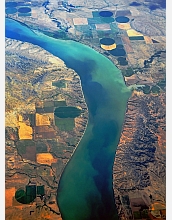News Release 08-010
Agriculture Changing Chemistry of Mississippi River
River outflow altering Gulf of Mexico waters

Farming practices have changed the chemistry of the Mississippi River and the Gulf of Mexico.
January 23, 2008
This material is available primarily for archival purposes. Telephone numbers or other contact information may be out of date; please see current contact information at media contacts.
Midwestern farming, and increased water flowing into the Mississippi River as a result, have injected the equivalent of five Connecticut Rivers' worth of carbon dioxide into the Mississippi each year over the last 50 years, according to a study published this week in the journal Nature.
The research is funded by the National Science Foundation (NSF).
"It's like the discovery of a new large river being piped out of the corn belt," said Peter Raymond, lead author of the study and an ecologist at Yale University. "Agricultural practices have significantly changed the hydrology and chemistry of the Mississippi."
The research team analyzed Mississippi River data as much as 100 years old. The data had been warehoused at two New Orleans water treatment plants.
"This impressive effort has led to important conclusions about the influence of land-use practices on carbon dioxide in the environment," said Martyn Caldwell, program director in NSF's division of environmental biology. "The implications for other materials being transported into river systems are significant."
The researchers tracked changes in the levels of water and bicarbonate, which forms when carbon dioxide in water in soil dissolves minerals. Bicarbonate plays an important, long-term role in absorbing atmospheric carbon dioxide, a greenhouse gas. Oceans then absorb carbon dioxide but become more acidic in the process.
"Ocean acidification makes it difficult, for example, for certain organisms to form hard shells," said Eugene Turner, a co-author of the paper and a marine ecologist at Louisiana State University.
The researchers concluded that liming and farming practices, such as changes in drainage and crop type and rotation, are likely responsible for the majority of the increase in water and carbon in the Mississippi.
The researchers believe that increased nutrients in the Mississippi also are altering the chemistry of the Gulf of Mexico, into which the Mississippi flows.
In addition to Raymond and Turner, co-authors of the paper, "Anthropogenically Enhanced Fluxes of Water and Carbon from the Mississippi River," are Neung-Hwan Oh of Yale and Whitney Broussard of Louisiana State University.
-NSF-
Media Contacts
Cheryl Dybas, NSF, (703) 292-7734, email: cdybas@nsf.gov
Related Websites
NSF Directorate for Geosciences: http://www.nsf.gov/dir/index.jsp?org=GEO
NSF Directorate for Biological Sciences: http://www.nsf.gov/dir/index.jsp?org=BIO
The U.S. National Science Foundation propels the nation forward by advancing fundamental research in all fields of science and engineering. NSF supports research and people by providing facilities, instruments and funding to support their ingenuity and sustain the U.S. as a global leader in research and innovation. With a fiscal year 2023 budget of $9.5 billion, NSF funds reach all 50 states through grants to nearly 2,000 colleges, universities and institutions. Each year, NSF receives more than 40,000 competitive proposals and makes about 11,000 new awards. Those awards include support for cooperative research with industry, Arctic and Antarctic research and operations, and U.S. participation in international scientific efforts.
Connect with us online
NSF website: nsf.gov
NSF News: nsf.gov/news
For News Media: nsf.gov/news/newsroom
Statistics: nsf.gov/statistics/
Awards database: nsf.gov/awardsearch/
Follow us on social
Twitter: twitter.com/NSF
Facebook: facebook.com/US.NSF
Instagram: instagram.com/nsfgov
